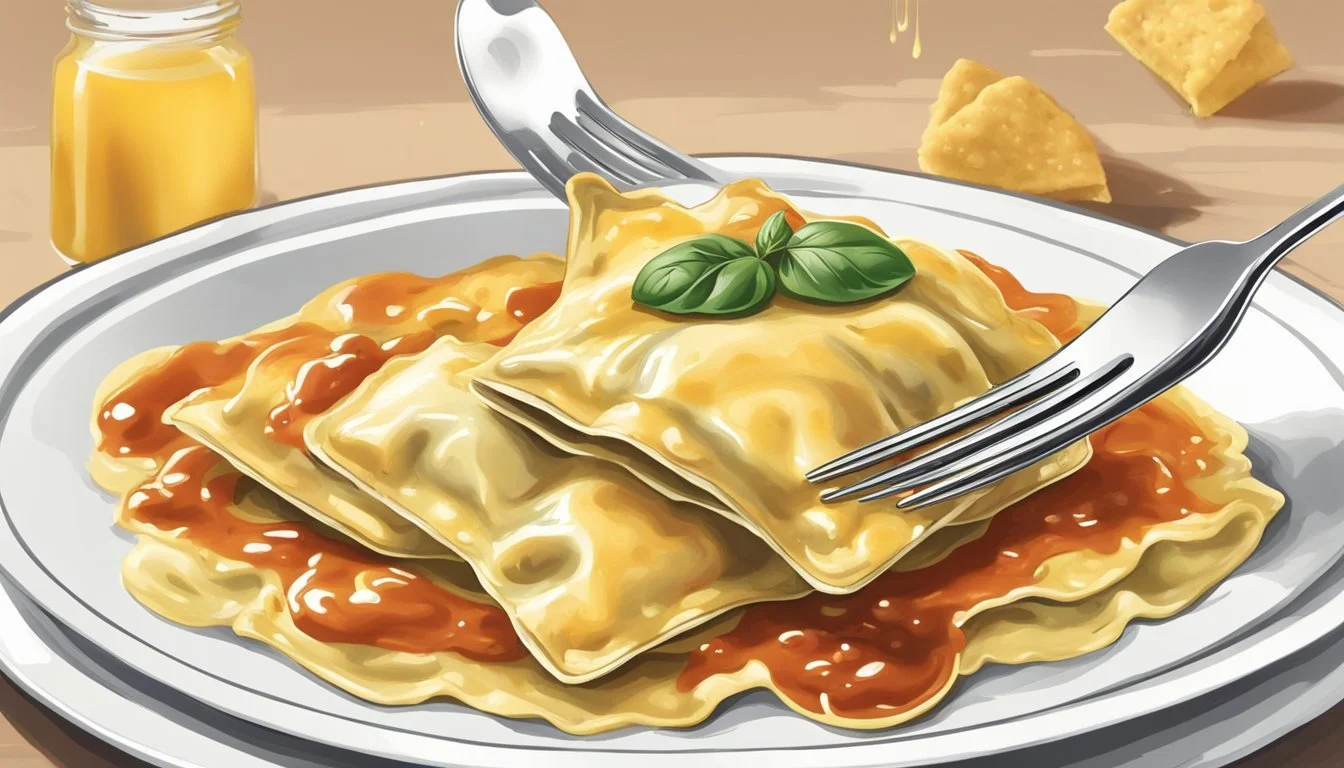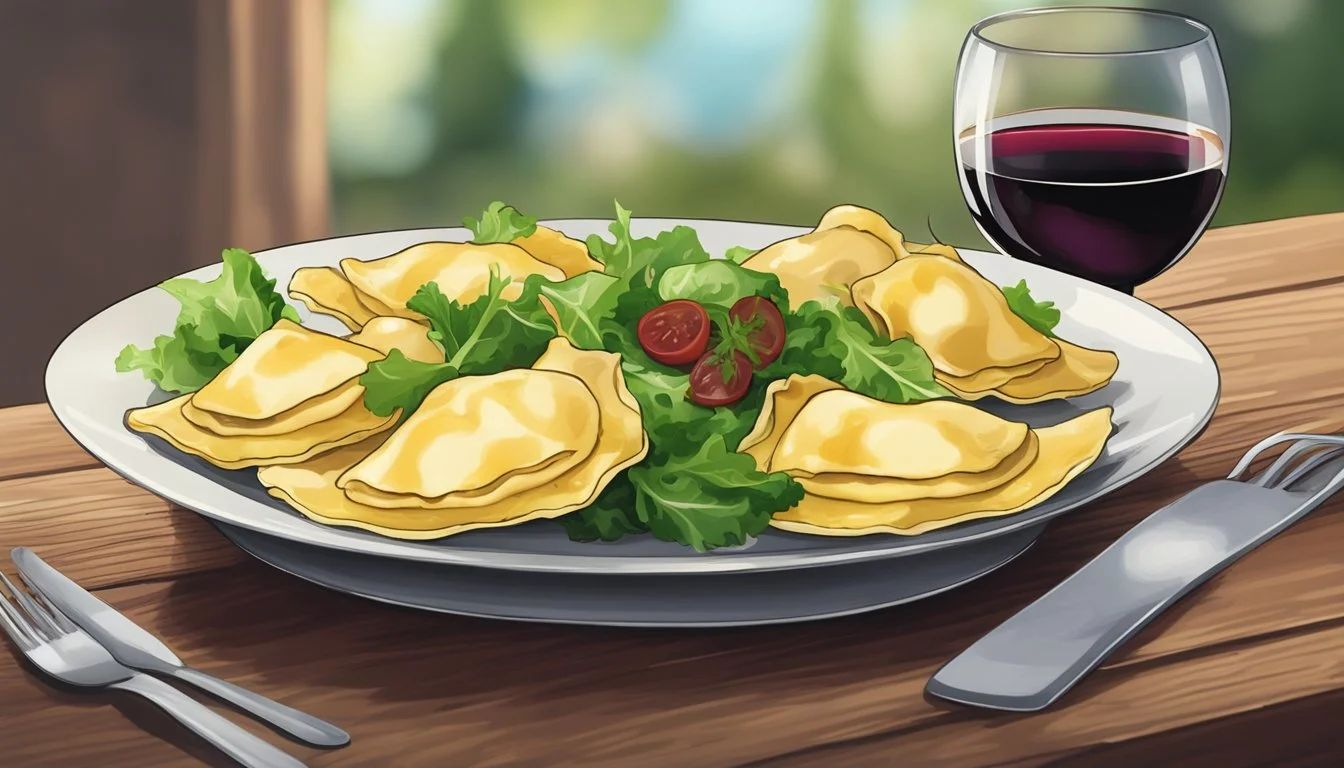How do you eat a ravioli?
Mastering the Art of Savoring This Italian Delicacy
Ravioli is a culinary delight that originates from Italian cuisine, captivating the taste buds of pasta (What wine goes well with pasta?) enthusiasts around the world. These pillowy pockets of pasta are traditionally filled with a variety of ingredients such as cheese, meats, vegetables, or even seafood, which influences the method of cooking and eating them. Each ravioli is a self-contained burst of flavor, carefully crafted to deliver a balanced bite that combines the textures of its tender pasta exterior with its rich and savory filling.
The process of enjoying ravioli is an exercise in savoring the careful preparation and blend of flavors that define this Italian specialty. They can be cooked in various ways, including boiling, microwaving, or baking, to achieve the desired tenderness and texture. The key to perfectly cooked ravioli lies in the attention to detail throughout the cooking process — from adding salt to the water to bring out the pasta's flavor, to gently stirring the ravioli to prevent them from sticking together.
When it comes to serving ravioli, simplicity often reigns supreme, allowing the flavors of the filling to shine through. A light drizzle of olive oil, a sprinkle of Parmesan cheese, or a modest ladling of tomato sauce are popular accompaniments that enhance, but don't overshadow, the taste of the pasta. The pairing of side dishes, such as asparagus (how long does asparagus last?) wrapped in prosciutto or a simple salad, can complement the meal, making ravioli not just a dish but a complete dining experience.
Ingredients and Varieties
Ravioli presents a culinary canvas, offering a myriad of filling possibilities and combinations of dough and sauces. The right blend of ingredients elevates this humble Italian dumpling to gourmet status.
Types of Filling
Ravioli fillings are diverse, ranging from cheese to meat, seafood, and vegetables. Traditional Italian fillings often include a mix of ricotta cheese with spinach, mushrooms, or butternut squash (how long does butternut squash last?). Seafood variations might offer a decadent filling of lobster. In meat options, a common choice is a mixture of ground proteins such as beef or pork with seasonings.
Dough and Texture
The dough encasing the filling is typically made from wheat flour, eggs, and water, creating a tender pillow that cooks to an al dente texture. Some versions may incorporate alternatives like gluten-free flour to cater to dietary restrictions. The thickness of the dough contributes significantly to the ravioli's texture, with a thinner dough highlighting the filling more prominently.
Popular Sauces
Ravioli can be accompanied by a variety of sauces. A classic tomato sauce or marinara is a favorite, but one can also find pesto, alfredo, and simple butter and olive oil mixtures enhanced with garlic. Each sauce can significantly alter the flavor profile of the dish, from the richness of alfredo to the fresh, herbaceous notes of pesto.
Choosing Accompaniments
Selecting the right side dishes can turn ravioli into a well-rounded meal. Roasted vegetables (What wine goes well with roasted vegetables?) like zucchini and parsnips, greens such as broccoli rabe and spinach, or starches like polenta and ciabatta bread make for excellent pairings. For a lighter touch, consider servings of garlic bread or salads. An antipasto platter or bruschetta can start the dining experience, while soup—perhaps featuring tortellini—can serve as a first course.
Preparation Techniques
When preparing ravioli, one should consider various cooking methods, seasoning options, the creativity of making personal ravioli, and using the right cookware to enhance the dish's quality.
Cooking Methods
Ravioli can be cooked in several ways, including boiling, baking, steaming, and even using a microwave. To boil ravioli, it's important to use plenty of water in a large pot and add a teaspoon of salt per quart to enhance flavor. For baking, ravioli can be coated in butter and breadcrumbs for a crispy exterior, baked in an oven preset to 375°F for 10-14 minutes. Steaming is a gentler method, requiring a pot with a steaming basket and a lid. Lastly, microwaving involves heating with a bit of water and sauce, stirring frequently for even cooking.
Seasoning and Flavoring
A well-seasoned ravioli dish starts with the cooking water; salt and a splash of olive oil can be added to prevent sticking. For garnishing and flavoring, consider a drizzle of high-quality olive oil, a sprinkle of garlic powder, or fresh herbs (how long do fresh herbs last?). Traditional sauces like marinara, pesto, and alfredo sauce can also be heated and spooned over the ravioli. For cheese-filled ravioli, a suitable pairing might be a simple tomato sauce to accentuate the filling's flavor.
Creating Your Own Ravioli
One can make your own ravioli with a basic dough filled with a preferred mixture of cheese, meats, or vegetables. After placing a spoonful of filling on a dough circle, one should brush the edges with an egg wash before sealing with another dough circle. Carefully pressing the edges with a fork to seal ensures the filling remains inside during cooking.
Ideal Cookware and Tools
The best results come from using the right equipment. A large pot with a well-fitting lid is essential for boiling or steaming. When baking, a nonstick baking sheet helps in achieving an evenly crispy texture. After cooking, a ladle or slotted spoon is recommended to remove the ravioli from the water, while a colander will effectively drain them. For those creating ravioli from scratch, tools like a pastry wheel, ravioli stamp, or cutter will aid in giving a professional finish to the pasta.
Serving and Presentation
Eating ravioli is as much about the enjoyment of flavors as it is about visual appeal and harmonious accompaniments. The following guidelines emphasize appropriate plating techniques, complementary side dishes, and drink pairings to elevate the dining experience.
Plating Techniques
For ravioli, aesthetics play a crucial role in serving. Arrange ravioli on a warm plate leaving space between each piece to showcase their shape and filling. If saucing, spoon the sauce over the pasta to enhance but not drench. A drizzle of high-quality olive oil or a sprinkle of fresh herbs adds both flavor and a splash of color.
Pairing with Side Dishes
The choice of sides can either contrast or complement the richness of ravioli. Consider light, crisp vegetables like asparagus or a salad to offset heavier fillings. For a heartier meal, oven-roasted vegetables or asparagus wrapped in prosciutto provide a delightful balance. Classic Italian sides like creamy polenta, broccoli rabe, or garlic bread are hearty yet traditional accompaniments that resonate with the pasta's texture.
Suggested Ravioli Side Dishes:
Light Sides:
Caesar Salad
Grilled Asparagus (What wine goes well with grilled asparagus?)
Hearty Sides:
Oven-Roasted Vegetables (carrots, broccoli rabe)
Creamy Polenta
Garlic Bread
Pairing with Drinks
When it comes to drinks, Italian wines stand out—they pair wonderfully with the varied flavors of ravioli. A light white wine complements cheese-stuffed ravioli, while red wines with good acidity balance meat-filled types. Non-alcoholic options like sparkling water with a lemon twist can refresh the palate without overpowering the pasta.
Suggested Drink Pairings:
For Cheese Ravioli:
Pinot Grigio
Chardonnay
For Meat Ravioli:
Chianti
Barolo
Non-Alcoholic:
Sparkling Water with Lemon
Storing and Reheating Leftovers
Proper storage and reheating are essential for enjoying ravioli leftovers while preserving their taste and texture. Adhering to temperature guidelines ensures safety, and correct reheating methods can maintain or even enhance the dish's quality.
Short-Term Storage
If ravioli are to be eaten within a few days, they should be stored in an airtight container in the refrigerator. They must be kept at a temperature below 40°F (4°C) to slow bacterial growth. One can line the container with parchment paper to prevent the ravioli from sticking to each other.
Freezing and Long-Term Storage
For long-term storage, ravioli are best kept frozen. First, they should be placed on a tray in a single layer, separated to prevent sticking, then transferred to the freezer briefly. Once solid, transfer them to a freezer-safe airtight container or wrap them in plastic wrap and aluminum foil. Properly frozen ravioli can last for up to 2 months.
Reheating Methods
When it's time to reheat, the ravioli can be warmed in an oven or microwave. For oven reheating:
Preheat to 350°F (175°C) for non-toasted and 375°F (190°C) for toasted ravioli.
Place them on a baking sheet or in a baking dish in a single layer.
For added moisture, cover with sauce if desired, or use foil to cover the dish.
Heat for approximately 10-15 minutes, flipping halfway if necessary for an evenly heated dish.
For microwaving:
Arrange ravioli in a single layer on a microwave-safe plate.
Microwave on medium power, checking at 30-second intervals to avoid overheating.
Maximizing Freshness
To keep reheated ravioli tasting fresh:
Don't stack ravioli during either storage or reheating, as this can lead to uneven heating or stickiness.
If ravioli are frozen, it’s better to thaw them in the refrigerator overnight before reheating to ensure even warmth.
One can also opt for an air fryer to reheat for a quick and crispy result. Set it to 350°F (180°C) and heat for 3-5 minutes.
Food Pairings and Complete Meals
When enjoying ravioli, diners can elevate their experience with a selection of starters, mains, and desserts that complement the taste and texture of this Italian classic. Careful selection creates a harmonious meal from beginning to end.
Complementary Starters
An antipasto platter offers a delightful start with a variety of flavors—from olives to cured meats (What wine goes well with cured meats?) like prosciutto—ideal for preparing the palate. A spring salad, with its fresh greens and a light vinaigrette, cleanses the taste buds and readies them for the rich, cheese-filled ravioli to come.
Accompanying Main Courses
Ravioli pairs well with a simple protein such as grilled chicken or Italian sausage, which can provide a balance to ravioli's richness. For seafood lovers, shrimp lightly sautéed with garlic and olive oil can complement a seafood or cheese-filled ravioli without overwhelming its delicate flavors.
Finishing with Desserts
To conclude, select desserts that are light and not overly sweet. A fruit sorbet cleanses the palate and contrasts beautifully with the savory ravioli. For those who prefer a bit more indulgence, a small portion of panna cotta garnished with fresh berries is an Italian dessert that rounds off the meal without heaviness.
Health and Dietary Considerations
When consuming ravioli, it is essential to consider any food allergies or intolerances, the nutritional content of the pasta and its fillings, and the availability of diet-friendly variations to accommodate specific dietary needs.
Allergies and Intolerances
Ravioli typically contains gluten due to the wheat flour used in pasta dough. Those with celiac disease or gluten sensitivity should seek out gluten-free alternatives. Common fillings like cheese and meat can also pose allergen risks; for example, cheese is a source of lactose, which might be intolerable for some individuals.
Nutritional Information
Calories: A standard serving of four ravioli pieces may contain approximately 250-300 calories.
Protein: Each serving can offer about 10 grams of protein, which is essential for body repair and muscle growth.
Fiber: Vegetable fillings, such as spinach or mushrooms, can increase the fiber content, aiding digestion.
Vitamins and Minerals: Ravioli can be a source of vitamins A and B12, calcium, selenium, and phosphorus, contributing to bone health and metabolic functions.
Diet-Friendly Variations
For those following specific diet plans, there are various ravioli alternatives:
Whole Grain Pasta: An option higher in fiber and nutrients than its white pasta counterpart.
Vegetable Fillings: Incorporating vegetables like spinach, mushrooms, or cherry tomatoes increases nutrient density and is suitable for vegetarians.
Lean Proteins: Opt for fillings with lean meats like chicken or turkey for a lower-fat content.
Healthy Fats: Preparing ravioli with olive oil instead of butter can provide heart-healthy fats.






